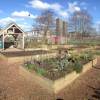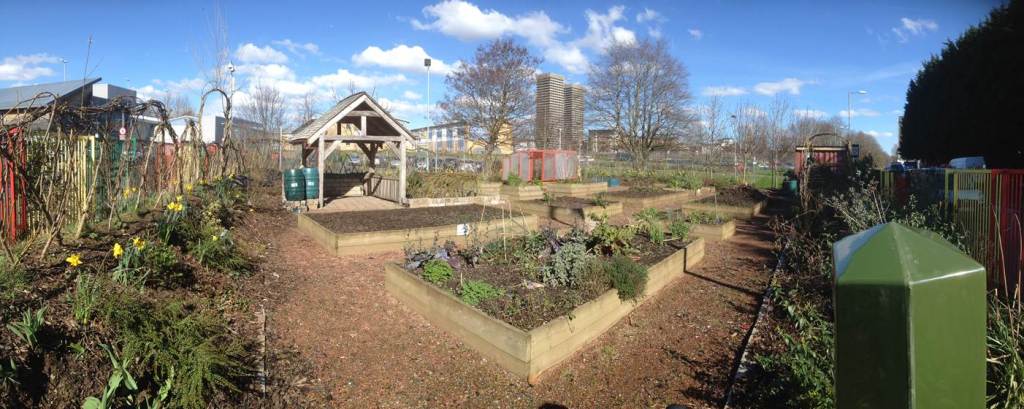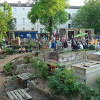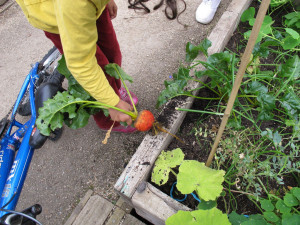“You get all sorts of characters in this place”
Crownpoint is one of the smallest gardens I’ve visited so far, occupying a 672 m^2 (or 0.166 ac). That being said it was also the busiest I’ve visited. I arrived at 1.30pm and within 20 minutes 15 people had shown up to work in the garden. The garden is situated on a fairly busy road (Crownpoint Road) that runs through Bridgeton, just beside the entrances to St Mungo’s Academy and the Glasgow Club Crownpoint Sports Complex. While there is no residential housing in the immediate vicinity of the garden, its position between these busy places means it sees a lot of footfall. The school janitors home once stood on the site and after being raised some years ago the site stood as a derelict space. Like G3 and other gardens the ground has pollutants, hence the raised beds. A protective membrane lies under the site. The raised planting space that runs around the garden was excavated from the original ground space therefore the soil is still contaminated. This area is used for growing non-edible flora.
Crownpoint has 15 raised beds of varying sizes, a small green house, a shed (which is actually a 10ft metal shipping container) and wooden shelter. Other notable structures are the willow fencing that circles a small pond and two composting units. The site has two rainwater barrels catching run-off from guttering along the wooden shelter. More recently the site has had a water mains connection put in. It grows much of the same produce as other gardens I have visited although there are no fruit trees. Produce is not weighed, although the new sessional gardener told me there are plans to initiate regular weighing and documenting of produce.
The garden has 1 part-time sessional worker, who is an employee of Playbusters (a community charity that operates in the East End). It offers three workshops that take place mainly during harvesting times: composting, grow you’re own and cookery workshops. The land was owned by Glasgow City Council although it, along with many other properties and lands, is now under the control of ‘City Property (Glasgow) LLP. As a community garden with some form of connection with GCC, the council’s sole Greenspace Officer regularly visits Crownpoint (I was told while on-site that due to council cut backs all other (no exact number) Green Space Officers lost there jobs). The garden has a committee but the main administrative and day-to-day organizing seems to be shared between Playbusters and the GCC, through the Greenspace Officer. There seems to be a fair bit of ambiguity surrounding the terms of lease on this space. From what I could gather the committee get it free on a rolling lease from ‘City Property, although I was told on the day that ‘City Property does not have a lease model for community gardens (worth looking into further).
As mentioned above, Crownpoint is a busy little garden, at least on the main volunteer days. As well as the part-time sessional worker there are two regular volunteers and 4 individual plot holders. In addition the garden has growing plots used by Lodging House Mission (local homeless charity), the local nursery, a local project for the deaf and hard of hearing and St Mungo’s academy. I spoke with both the teacher supervising the group of pupils and some of the pupils. The garden is used as part of 6th year studies option that allows pupils the opportunity to pick up ‘life skills’ by working out with the school itself. The teacher told me that the school is looking into collaborating with the garden on providing more specific horticultural related educational awards.
In the 2.5 years since the garden began it has received approximately £26,000: £15,000 Climate Challenge Fund, £10,000 Glasgow City Council and £900 from the Stalled Spaces Fund (another GCC fund). Related to the matter of finances the GCC Green Space Officer has concerns for the garden’s future. In his experience community gardens work best when there are full-time gardeners on-site. The Playbuster’s Community Gardener voiced concern about the ambiguity of the lease for Crownpoint.
My overall experience of the garden was highly enjoyable. This is a garden that seems to have a lot of potential in terms of community cohesion in that it has, as one volunteer told me, “allsorts of characters” enjoying it: teenagers, people with disabilities, professionals and children from the local nursery. According to the Greenspace Officer it has good growing potential and provided a good yield last season. The St Mungo’s academy staff and pupils supported this position, telling me last seasons yield was regularly used by the school’s catering service. The lease situation and issue around whose actually managing the space remains a conce
John Crossan



